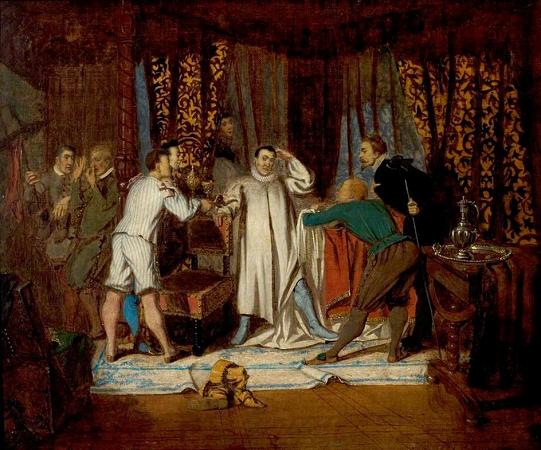
Edward Matthew Ward. Edward Matthew Ward was an English Victorian narrative painter best known for his murals in the Palace of Westminster depicting episodes in British history from the English Civil War to the Glorious Revolution.
Ward was born in Pimlico, London. As a youth, he created illustrations for the well-known book Rejected Addresses, written by his uncles James and Horace Smith.
He also created illustrations to the papers of Washington Irving. In 1830 he won the silver palette from the Society of Arts.
With support from David Wilkie and Francis Leggatt Chantrey, he became a student at the Royal Academy Schools. In 1836 he travelled to Rome, gaining a silver medal from the Academy of St Luke in 1838 for his Cimabue and Giotto, which in the following year was exhibited at the Royal Academy.
While a student at the Schools, Ward became a member of The Clique, a group of painters led by Richard Dadd. Like other members of the Clique Ward saw himself as a follower of Hogarth and Wilkie, considering their styles to be distinctly national in character. Many of his early paintings were set in the eighteenth century and were on Hogarthian subjects. He also painted episodes from seventeenth century history, influenced by the thinking of his friend, the historian Thomas Babington Macaulay. He also painted subjects from the history of the French Revolution. In 1843 he entered the Palace of Westminste
Ward was born in Pimlico, London. As a youth, he created illustrations for the well-known book Rejected Addresses, written by his uncles James and Horace Smith.
He also created illustrations to the papers of Washington Irving. In 1830 he won the silver palette from the Society of Arts.
With support from David Wilkie and Francis Leggatt Chantrey, he became a student at the Royal Academy Schools. In 1836 he travelled to Rome, gaining a silver medal from the Academy of St Luke in 1838 for his Cimabue and Giotto, which in the following year was exhibited at the Royal Academy.
While a student at the Schools, Ward became a member of The Clique, a group of painters led by Richard Dadd. Like other members of the Clique Ward saw himself as a follower of Hogarth and Wilkie, considering their styles to be distinctly national in character. Many of his early paintings were set in the eighteenth century and were on Hogarthian subjects. He also painted episodes from seventeenth century history, influenced by the thinking of his friend, the historian Thomas Babington Macaulay. He also painted subjects from the history of the French Revolution. In 1843 he entered the Palace of Westminste
Wikipedia ...